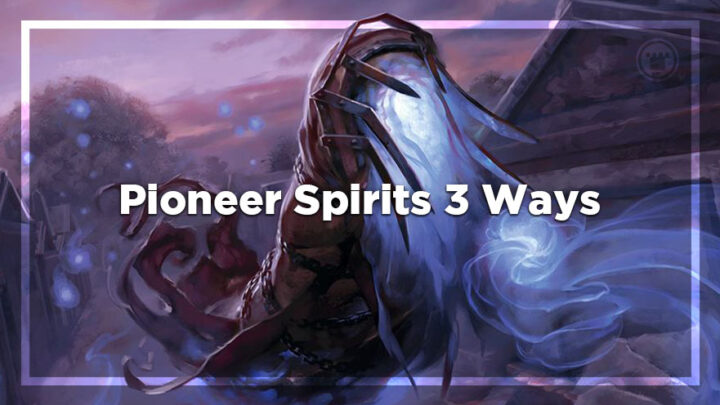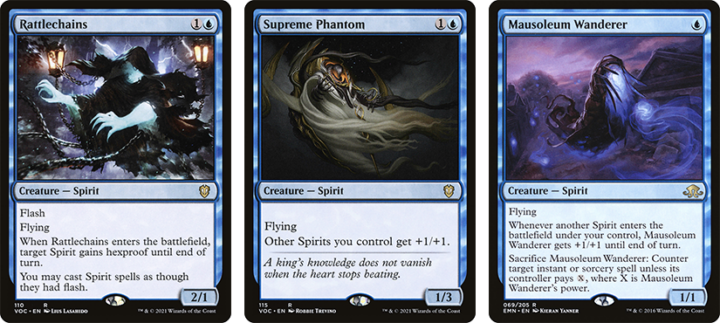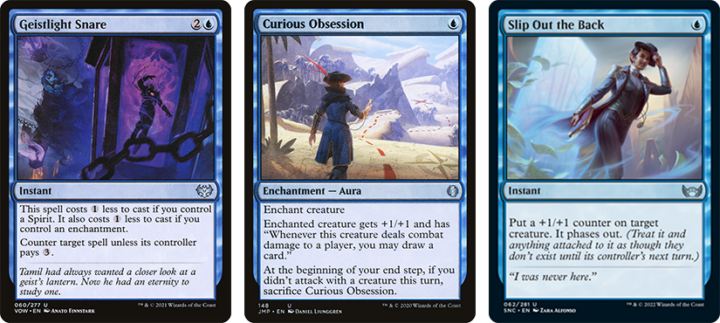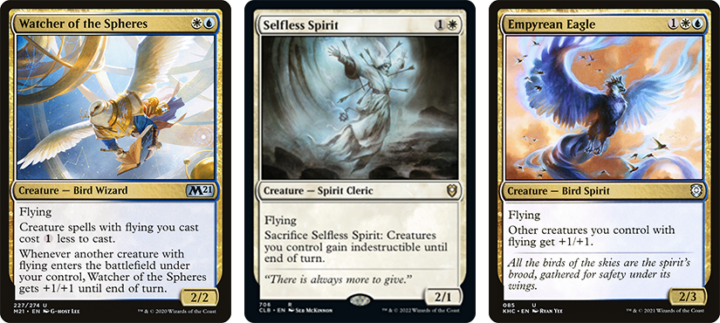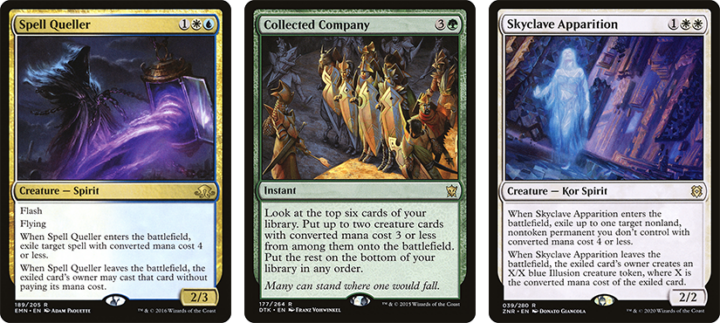With Pioneer RCQ Season coming up, Michael takes a look at three versions of a popular archetype: Spirits!
It is fairly common to see a broad strokes archetype have a variation to handle different challenges in the metagame, think Grixis vs Jund vs Mardu Death’s Shadow in Modern. However, it is much rarer for an archetype to have three successful variants concurrently. Pioneer Spirits is currently seeing success as Mono Blue, Azorius, and Bant. In the last two weeks Bant and Mono Blue have both won a challenge, with Azorius putting up reasonable results of its own. When an archetype is performing as well as Spirits it deserves a closer look, especially as a popular and affordable option for the upcoming RCQ season!
What is Spirits?
Before I start breaking down the different color combinations, we should go over what Spirits the core archetype is, and what it wants to do. At its core, Spirits plays like Humans, as a disruptive aggro deck, using Supreme Phantom to buff smaller cheap creatures such as Mausoleum Wanderer. Spirits are right at home in a racing scenario as all of their creatures have flying, making blocking difficult for the opponent.
Lofty Denial, Geistlight Snare, Spell Queller, and Mausoleum Wanderer give Spirits a healthy amount of interaction for the stack, which is important, given their lack of removal for troublesome creatures. Tribal decks tend to struggle to interact, which is what sets Spirits apart, in my mind. Having an aggressive plan backed up by counterspells, while also being able to play a flash game makes Spirits adept at beating combo decks, and can give control decks a fit. The ideal gameplan for Spirits is to get an early creature or two in play, and then hold up either a counterspell or a flash creature, which punishes your opponent if they play around the wrong one. Now that we know what Spirits is trying to accomplish, let’s take a look at the different builds!
Mono Blue
Mono Blue Spirits is the most successful of the three versions at the moment. Mono Blue is also the most tempo oriented of the three sporting a full set of Curious Obsession, which makes you keep attacking and keep the pressure high. Ideally, the first two turns of the game are either Mausoleum Wanderer, Spectral Sailor, or Ascendant Spirit, into Curious Obsession plus Geistlight Snare. This makes sure that you have a stream of extra cards coming as long as you’re attacking, and that you can either protect your creature, or stop your opponent’s development. While Lofty Denial isn’t quite Counterspell, it does a pretty good impression when you have a flying creature in play. Rattlechains does an excellent job at protecting your creatures from removal spells, while also adding to the board, exactly what Spirits wants. Shacklegeist helps solve some of Mono Blue’s removal problems by tapping Cavalier of Thorns and other reach creatures.
Mono Blue succeeds against most linear decks that don’t interact much. Lotus Field, Jeskai Ascendancy and Greasefang are excellent examples. Mono Blue is also strong against decks that play a lot of expensive spells, which lets their soft permission be relevant later in the game. Niv to Light, and to some degree Mono Green are vulnerable to this play style as well.
Mono Blue tends to be weak against removal heavy decks, like Rakdos Midrange, Izzet Phoenix, and Mono Red. If these decks can keep Supreme Phantom off the board the remaining Spirits creatures are easy to clean up, as long as they’re careful of Rattlechains.
Azorius
Azorius Spirits takes the core of Mono Blue, and adds white for Selfless Spirit, Skyclave Apparition, Spell Queller, Empyrean Eagle, Watcher of the Spheres, and sideboard cards. Adding the white cards comes primarily at the cost of Geistlight Snare, Slip Out the Back, and Curious Obsession. The addition of Spell Queller means that the total number of counterspells stays relatively the same.
Azorius Spirits gains the ability to be more aggressive, Empyrean Eagle is a second lord to back up Supreme Phantom, making otherwise undersized Spirits into real threats. Watcher of the Sphere is both an aggressive two drop, getting bigger when another flier enters your battlefield, but is also a cost reducer for almost every creature in the deck. Spell Queller is an amazing tempo play, similar to Rattlechains, countering an opponent’s spell while adding a creature to your board is going to generate large swings in most games. Skyclave Apparition lets Azorius Spirits interact with the board on some level, being able to clear out non-land permanents mana value four or less.
Without Slip Out the Back, Rattlechains plays an even more important role in Azorius Spirits, because if Spell Queller or Skyclave Apparition is removed, your opponent gets something back as well. Selfless Spirit can also help in this regard, while even protecting from Anger of the Gods or Supreme Verdict.
Rest in Peace out of the sideboard gives Spirits an additional game against graveyard decks, like Izzet Phoenix, which is usually a less than stellar matchup. Portable Hole rounds out the white cards, letting Azorius Spirits deal with cheap creatures such as Thing in the Ice, or most creatures from Mono Red.
Overall, Azorius Spirits trades some of the tempo game plan in for being able to build bigger boards, which combat red removal, which is fairly common, getting it’s creatures out of range of the various Shock effects. I’d expect Azorius Spirits to be better against Mono Red, and Izzet Phoenix, but likely worse against Mono Green, given the loss of Geistlight Snare, while remaining roughly the same against combo.
Bant
When I hear someone talk about Spirits, Bant is the version that always pops into my head. Bant plays very similarly to Azorius Spirits, except it drops Watcher of the Spheres for Collected Company. All of the other main deck white cards are the same, and this particular Bant deck has no green cards in the sideboard.
So why would players make their mana worse by adding a third color to the deck, just for Collected Company? The answer is simple, Collected Company is one of the best cards there is against decks with interaction and sweepers. If a Spirits player passes the turn with four mana up, do they have a Rattlechains? Spell Queller? Can you try and kill a creature, and hope they don’t Collected Company into any of their ways to prevent that? Combat math becomes a nightmare, because if they have Collected Company into a lord, or a Skyclave Apparition, suddenly your blocks, or racing math gets thrown way off. Spirits players need to be careful about committing too much to the board when faced with Anger of the Gods or Supreme Verdict, but Collected Company let’s them either rebuild after a sweeper, or if the opponent didn’t cast one, add two creatures to the board and really turn up the heat.
Bant has no main deck counterspells except for Spell Queller, so I’d expect that this is the worst version against combo and Mono Green. However, Bant is likely the best version against Phoenix, Azorius Control, and Rakdos Midrange, so if you expect the metagame to be fair and midrangey, Bant would be my pick.
Phew, there sure is a lot to cover when it comes to Pioneer Spirits. I hope that if you’re looking to get into Pioneer, or if you’re interested in disruptive aggro/tempo decks that you’ll give Spirits a try this coming RCQ season!
As always you can find me on Twitter at @RappaciousOne for questions, comments, and feedback. I’ll see everyone back here next Friday!

Michael Rapp is a Modern specialist who favors Thoughtseize decks. Magic sates his desire for competition and constant improvement.

